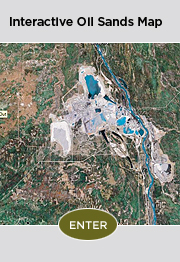| After more than 40 years, oil sands mining has disturbed an area of about 530 square kilometres. As required by law, all lands disturbed by the oil sands must be reclaimed. Out of approximately 530 square kilometres of land disturbed by oil sands activities, 65 square kilometres of oil sands lands are currently under active reclamation. The first oil sands mining reclamation certificate was issued to Syncrude Canada Ltd. in March 2008. Tailings are produced at oil sands mines through the oil sands extraction process. Tailings are a mixture of water, clay, sand and residual bitumen produced through the extraction process and are often stored in tailings ponds or discontinued mine pits where the mixture is left to settle. Once the solids have been settled, the water can be reclaimed and recycled back in to the extraction process; more than 85 per cent of the water used by a typical oil sands mining operation is water recycled from the tailings operation. |
Today’s mining and upgrading technology and research is focused around ways to accelerate the settling process of tailings, to reduce or eliminate tailings ponds altogether, to speed-up the reclamation of the land and to reduce the amount of energy used in the extraction process.Examples of recent oil sands mining innovations include:
- Syncrude’s low energy extraction process (Aurora Mine) operating at approximately 40ºC. At these temperatures, the new Low Energy Extraction process consumes about one-third of the energy used in the conventional 80ºC process.
- Shell and Exxon’s high-temperature froth treatment using higher temperatures to remove impurities from oil sands froth. This technology allows for the use of smaller equipment, less water and less energy, cutting emissions by approximately 10 to 15 per cent.
- CNRL’s CO2 injection process (Horizon Mine) involving injecting waste carbon dioxide (CO2) into the tailings slurry lines before the tailings enter the pond, allowing the tailings mixtures to settle quickly and leave clearer water for recycling and reusing in the bitumen extraction process.
- The oil sands mining industry’s use of various methods of consolidated tailings (CT) and non-segregating tailings (NST) to speed the tailings settling process. Gypsum is added to the mixture to encourage particles to conglomerate to form a more solid landscape. Over time, the mixture becomes more solid and releases water. This water is recycled back to the extraction plant for use in the separation process.
- Suncor Energy’s recently submitted regulatory application for Tailings Reduction Operations (TRO). TRO involves converting fluid fine tailings more rapidly into a solid landscape suitable for reclamation. In the process, Suncor’s fine tailings, which settle out over the course of two to three years to a yogurt-like material called Mature Fine Tailings, are mixed with a polymer and deposited in thin layers over areas around the tailings ponds where they consolidate to a solid form. The process results in a dry material capable of being reclaimed in place or moved to another location for reclamation.
- In addition, technologies such as freeze-thaw evaporative drying and centrifugation are also in advanced stages of pilot testing…all focused on speeding up the settling of tailings so that the land can be reclaimed more quickly.
|
|




















